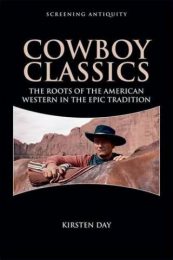Kirsten Day’s title is the latest publication in the series ‘Screening Antiquity’ by Edinburgh University Press, the only series of academic monographs focusing on new research concerning the reception of the ancient world in film and television and the conception of antiquity in popular culture.
 At first, there would be reservations connecting the book’s title characters, the Cowboy, to the ancient world and antiquity; for the cowboy only arrived in the US at little less than 150 years ago.
At first, there would be reservations connecting the book’s title characters, the Cowboy, to the ancient world and antiquity; for the cowboy only arrived in the US at little less than 150 years ago.
But the subtitle nevertheless makes sense, for there actually is a strong connection between ancient epic tradition and many westerns, especially those of the Golden Days of Westerns.
Instead of locating the many parallels between American Western movies and Greek and Roman epic in dozens of films, she wisely concentrates on just five westerns produced between 1948 and 1962, heavyweights, though: High Noon, The Man Who Shot Liberty Valence, Red River, the Searchers, and Shane.
At the basis of her study is the idea of comparing two genres, namely (epic and ancient) literature with (modern day) film, i.e. to use identical strategies to uncover, distinguish and research respective aims, methods and effects. The study also illustrates the two differing schools that approach popular culture either through the “classical receptions movement” – where the use of manifestations of classical culture is tested against later periods – or the “classical tradition,” that aims to detect the influence of classical works on later works of literature or art.
Day is easily recognizable as a scholar of the classical receptions theory.
“…[A]nalyzing the dynamics at play in ancient epic as a means of shedding light on works from popular culture provides the distance that allows us to see Western films, in whose ideological undercurrents we are more directly implicated, in a more objective light. In doing so we can more effectively take into consideration what they reveal about our own twentieth/Twenty-first-century world and its relationship to the Greco-Roman civilizations that are our cultural ancestors.”
The countless challenges of life in the West and the strong local and national traits that were presented in film, elevated the Westerns to more than simple movie entertainment; they also were highly instrumental in “… helping Americans understand their roots and define their cultural identity.”
Both in the epic and the Westerns, certain traits, unique national features and characteristic requirements in the men who once built the Greek and Roman nations and later were responsible for the national character of the US, Day suspects. “Because of the entrenched nature of these associations, I content that generalized American audiences necessarily read the presentation of such things as heroism, masculinity, honor, women’s roles, confrontation, and conflict in ancient epic through a ‘Western’ lens.”
The basic obvious parallels between the two forms of storytelling were discovered decades ago by scholars of film, literature, philosophy and political science. Day, however, covers a number of aspects exploring both genres and goes in detail concerning important aspects of the heroic characters such as (sparse) language used, the complex system of ideal manhood (and gender roles in general) and the insistence on standing one’s ground to fight for an ideal or justice. Nevertheless, “…the Western hero as he is resented in film has become a pervasive and persistent model for idealized American masculinity more generally,” says Day.
Her solid chapter on High Noon in particular makes this very clear.
Recommended reading for any fan of Westerns, classic epic or scholar of American Studies.
Kirsten Day. Cowboy Classics: The Roots of the American Western in the Epic Tradition. (Screening Antiquity). Edinburgh University Press, 2016, 230 p.
